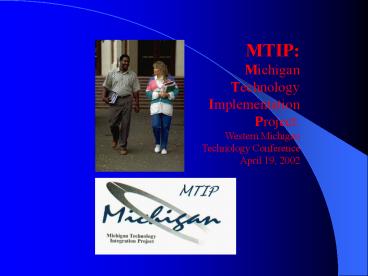MTIP: Michigan Technology Implementation Project: - PowerPoint PPT Presentation
Title:
MTIP: Michigan Technology Implementation Project:
Description:
Title: PowerPoint Presentation Author: ndanhof Last modified by: ndanhof Created Date: 11/16/2001 2:09:50 AM Document presentation format: On-screen Show – PowerPoint PPT presentation
Number of Views:58
Avg rating:3.0/5.0
Title: MTIP: Michigan Technology Implementation Project:
1
MTIPMichigan Technology Implementation
Project Western Michigan Technology Conference
April 19, 2002
2
The Future is NOW!!!
- Ready or Not . . .The World is Different
- Work is different ...
- Tools are different ...
- Communication is different ...
- Information is different ...
- Kids and Educators are different ...
- And Leading Is Different!
3
Leaders Know Change is Cultural
- Transforming the culture changing the way we
do things around here is the main pointLeading
in a culture of change means creating a culture
(not just a structure) of change. It does not
mean adopting innovations, one after another it
does mean producing the capacity to seek,
critically assess, and selectively incorporate
new ideas and practices all the time, inside
the organization as well as outside the
organization. - Michael Fullan, Leading in a Culture of Change
4
MTIP ...
- Provides interrelated services that are designed
to assist local efforts. - Coordinates state and regional technology
efforts. - Promotes efficiency through collaboration and
partnerships.
5
The Four MTIP Centers Diverse But Interdependent
Roles
- Information Development
- Sustained Learning
- Capacity Building and Accountability
- Awareness and Dissemination
6
Center for Capacity Building and Accountability
- Helping to assure local districts can continue
the learning after the Grant support is gone.
7
What Makes A Difference?
- January 23 Grand Rapids Symposium
- Pitfalls and Pinnacles
- 61 educators that included
- Superintendents
- Principals
- Curriculum Directors
- Tech Coordinators
- Board Members
- Teachers
8
What We Found Out
Transform Education Culture Complex Messages And Goals Efficient Effective Use Planning and Implement Vision and Leader- ship Support for Change
Working out of old paradigm Conflicting Goals MEAP vs. Inquiry Scarce Resources Funding Model vs. Educational Model Minima.l Technology Vision Training and Prof. Develop.
Insure meaningful learning Lack of knowledge for impact of tech. Inequity Issues Implement District Technology Plan Vision and Leadership for Integration Personal Use
Pushing my comfort envelope TCO and TCM Keeping Pace P.D., Upgrades, Resources Commit to new Culture
9
What Does It All Mean?
- Identified Six Strategies for Building Capacity
in Local Districts - Research
- Tech. Standards for School Administrators
- Administrative Training
- Governance Changes
- Leadership Toolkit
- How Technology Affects District Policy
10
CCBA Projects and Tools
- Technology Standards for School Administrators
- AUP Policy Template
- Interactive Policy Site
- Leadership Toolkit Website www.technologyleaders.o
rg - Policy Research Paper and Research sites
- Administrative Training
11
TSSA The Target Product
- Technology Standards for all Pre K 12
Administrators - Standards for Superintendents and Superintendent
Cabinet Members - Standards for Principals and Assistant Principals
- Standards for District Level Leaders of Academic
and Special Programs
12
Framework For the Standards
- Six standards categories
- Statements for each category giving a broad
definition of the category - Performance indicators that further define the
statement - Role specific tasks for Superintendents, District
Program Directors and Principals - Scenarios for Superintendent, Central Office, and
Principal
13
Standards for School Administrators
- Leadership and Vision
- Learning and Teaching
- Productivity and Professional Practice
- Support, Management, and Operations
- Assessment and Evaluation
- Social, Legal, and Ethical Issues
14
How Will the Standards be used?
- A self assessment for administrators
- Understanding the systems nature of leadership in
technology 3 types of leadership - To inform education administration programs
- Provide insight for administrators in defining
the culture shift necessary for successful
integration of technology. - Give industry leaders an understanding of what
administrators face - Provide guidance for hiring, professional
development and evaluation of administrative
staff - WHAT ELSE
15
Whats Next?
- Finalize any changes we want to make in Michigan
- Submit to MDE for consideration
- Use in Gates Grant activities
- Meet with colleges and universities
- Align professional development offerings and
voluntary certification programs with standards
16
What can you do?
- Use the Michigan resources at http//www.technolog
yleaders.org/ - Watch the MTIP website for Michigan developments
at www.mtip.net - Develop ways you can use the TSSA Standards in
your job and in your district































